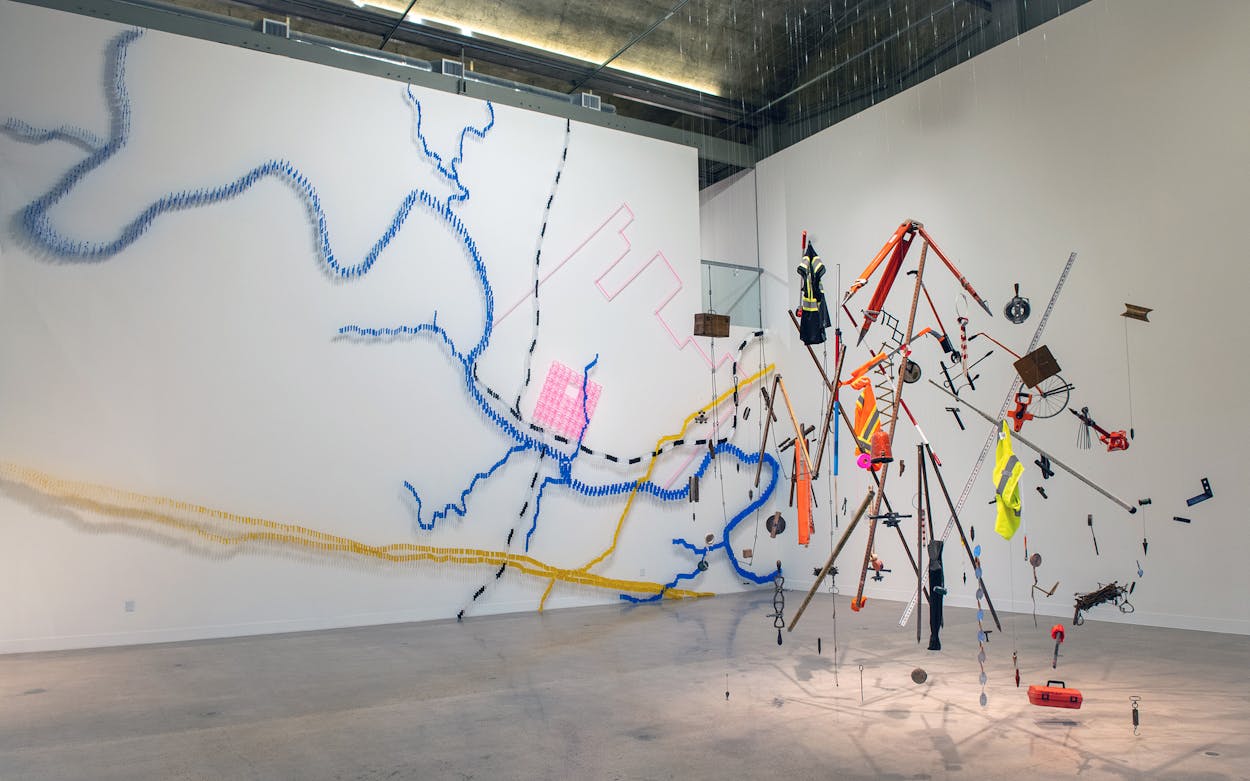Anyone who’s ever taken a long drive through West Texas knows that it’s a region of gorgeous landscapes with very few places to get out and stretch your legs. Unlike in other Western U.S. states that entered the Union under different circumstances and with a greater role for federal land management, the vast majority of Texas land, about 95 percent, is privately held. Property fences run along most rural Texas roadways, and often right up to the edges of waterways, making almost the entire state inaccessible to its citizens.
Those endless fences and that sense of estrangement from the local environment were early inspirations for The Blessings of the Mystery, the dizzyingly ambitious West Texas road trip turned art project by Los Angeles–based artists Carolina Caycedo and David de Rozas, which opened in September at the University of Texas Visual Arts Center in Austin and will soon travel to venues in Marfa and El Paso. The show includes, for example, 44 intricately drawn patent diagrams for different types of fences popular in Texas going back to the nineteenth century—plus one diagram of the “contiguous and impassible” wall along the Rio Grande authorized by Donald Trump’s executive order on January 25, 2017.
The Blessings of the Mystery is about much more than just fences or recent politics, however. It’s a wide-ranging critique of Texas civilization itself—at least so far as land use is concerned—beginning with the conquest of Indigenous peoples and extending through a history of surveying, parceling, and dam-building, to our present era of fracking and real-estate speculation. Audiences who don’t appreciate a couple of Californians (to be fair, Caycedo and de Rozas are European-born international artists who’ve settled in L.A.) telling them what’s wrong with Texas are advised to steer clear of this show, which can verge on didactic and sentimental. For more receptive visitors, Blessings of the Mystery’s occasional faults will be more than redeemed by its deep appreciation for the beauty of the West Texas landscape, its moral clarity, and its sense of cosmic possibility.

The exhibition includes several works of large-scale installation art, such as an eye-catching assembly of vintage surveying tools hanging from the ceiling of one gallery and a giant wall map of nineteenth-century Austin traced with surveying flags. (At the exhibition’s future stops, the artists intend to remake the wall map to depict early Marfa and El Paso.) The show also features a beautifully photographed 47-minute film, shot with actors in and around Marfa, with narration by Juan Mancias, chairman of the Carrizo/Comecrudo Tribe of Texas. The film touches on an alleged massacre of hundreds of Indigenous people near Del Rio in the early 1800s and includes dramatizations of surveyors in the early decades of Texas statehood and discussions of the meaning of the rock art of the Lower Pecos Canyonlands. The archaeological claims in the film should be taken with a grain of salt, however, such as the part when Mancias says confidently of the White Shaman mural, perhaps four thousand years old and of contested meaning: “It’s just a matter of knowing the language to understand it.”
The best elements of The Blessings of the Mystery, in contrast, are when Caycedo and de Rozas take a step back from pat explanations and instead simply present the fascinating objects and materials they’ve uncovered in their research process, facilitated by curators Laura Copelin and Daisy Nam of Ballroom Marfa. Display cases contain, for example, cores of earth collected by Shell Oil in 1950 when excavating tiny-circumference holes up to 20,000 feet deep in search of oil; vintage postcards celebrating biodiversity, the spiritual world, and oil and space exploration in Texas; and a pair of preserved fish specimens, one of which went extinct after the Amistad Dam was built near Del Rio, and the other of which recently traversed transborder underground aquifers from Mexico to a new habitat beneath the United States.
The pièce de résistance of the exhibition’s found-art displays is a series of 1930s watercolors by Forrest and Lula Kirkland from UT’s Archaeological Research Laboratory depicting ancient Native American rock art of the Lower Pecos and Rio Grande canyons around what would become Lake Amistad. This rock art, including the famous White Shaman mural, is probably Texas’s greatest archaeological patrimony, but much of it has been threatened and even erased in recent decades by inundations and unnatural humidity from the nearby man-made lake. The Kirkland watercolors, which have barely ever been seen before by art audiences, capture the full original color and depth of this ancient Indigenous rock art. These pieces alone are worth the price of admission—or would be, if it cost anything but time to visit the show.
The Blessings of the Mystery can occasionally feel overstuffed; overflowing with big ideas, some of them more developed than others. The notion of a relationship between the gas flares of the Permian fracking fields and the need for dark skies around McDonald Observatory is particularly timely but seems to drift into the background. The film, meanwhile, devotes much of its run time to sharing the peaceful, anti-accumulative wisdom of Indigenous Texas as voiced through Mancias, but it might be more illuminating if it also engaged with the more territorial warrior values of the Comanche and Lipan Apache, who are more prominent in written histories of West Texas than the Carrizo/Comecrudo.
We don’t need to sentimentalize the precolonial past to come to the conclusion that today’s Texas was built on settler-colonialist violence and exclusion and remains a deeply screwed-up culture when it comes to our land and natural resources. But how do we change? Are we forever doomed to see our surroundings only as territory ripe for extraction? Is there another, better logic of connection to the land we could still tap into that is at all compatible with who we have become? These are the mysteries we’re left to grapple with as we leave the exhibition, chastised and in need of a blessing.






